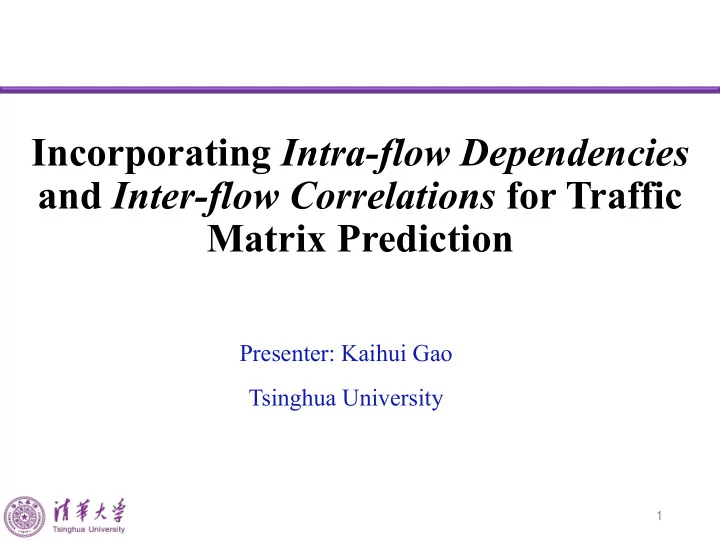

Incorporating Intra-flow Dependencies and Inter-flow Correlations for Traffic Matrix Prediction Presenter: Kaihui Gao Tsinghua University �
Catalog 1. Background 2. Related Works 3. Motivation 4. Data Analysis of Traffic Matrix 5. Challenge 6. Solution 7. Evaluation �
Background • Accurate TM prediction plays an important role in the areas of traffic engineering (TE), capacity planning, resource allocation, congestion mitigation, and failure/anomaly detection in computer networks. • For network traffic, as a kind of spatial-temporal series, its forecasting has to face similar key challenges of modeling sequential information as the traditional time series forecasting problem. Furthermore, accurate forecasting requires addressing the challenges of modeling the complex and underlying spatial correlation. �
Problem Formulation • TM: Traffic Demand Matrix • (TM t+1 ,TM t+2 ,…, TM t+q ) = f(TM t ,TM t-1 ,…,TM t-w+1 ) 11 4 3 9 7 6 10 12 2 1 8 � 5
Related Works • ARMA, ARIMA (Auto-regressive Integrated Moving Average) linear structure cannot model the nonlinear patterns • • SVR (Support Vector Regression) • significant effort is needed to tune its parameters • Neural Networks (NNs) based approaches RNN: LSTM, GRU • �
State-of-the-art: RNN TM t+1 … TM t TM t-1 TM t-w+2 TM t-w+1 �
Motivation • Popular service ——> positive correlations • Bandwidth contention ——> negative correlations request response client1 server client2 response request �
Spatial correlation analysis Pearson Correlation Coefficient: Observation 1: There exist abundant high correlations between flows in real WAN. �
Spatial correlation analysis Observation 2: Most strongly-correlated flow pairs share the same source or destination. �
How to capture spatial correlations • Explicitly • high computational overhead • curse of dimension • time-varying • Implicitly • learning based • convolutional neural network ��
Solution • We propose a novel deep learning framework combined CNN and RNN to predicting future traffic matrix. • Combined of • CNN capture the spatial correlations of every flow pair. • RNN model the temporal variation of spatial correlations and traffic. ��
Overview ��
Evaluation • Datasets: Abilene and GEANT • training set : test set = 8 : 2 • Performance Metric: • Mean Square Error • Mean Absolute Error • Baseline: ARIMA, SVR, LSTM, CNN ��
Predicting Next Single TM ��
Predicting Next Multiple TMs ��
Traffic Engineering based on TM Prediction • TE problem: given a network with edge capacities and a set of traffic demands of source-destination pairs, we try to find an assignment of demands to paths (an ordered sequence of edges) that optimizes some objectives. A widely used TE objective is minimizing the maximum link utilization (MLU). • Multicommodity Flow (MCF) problem • Baseline � • MCF based on real TMs • MCF based on predicated TMs by CRNN • MCF based on predicated TMs by LSTM • shortest path routing (SP) • Oblivious routing (OR) ��
Performance comparison ��
!������ ��
Recommend
More recommend